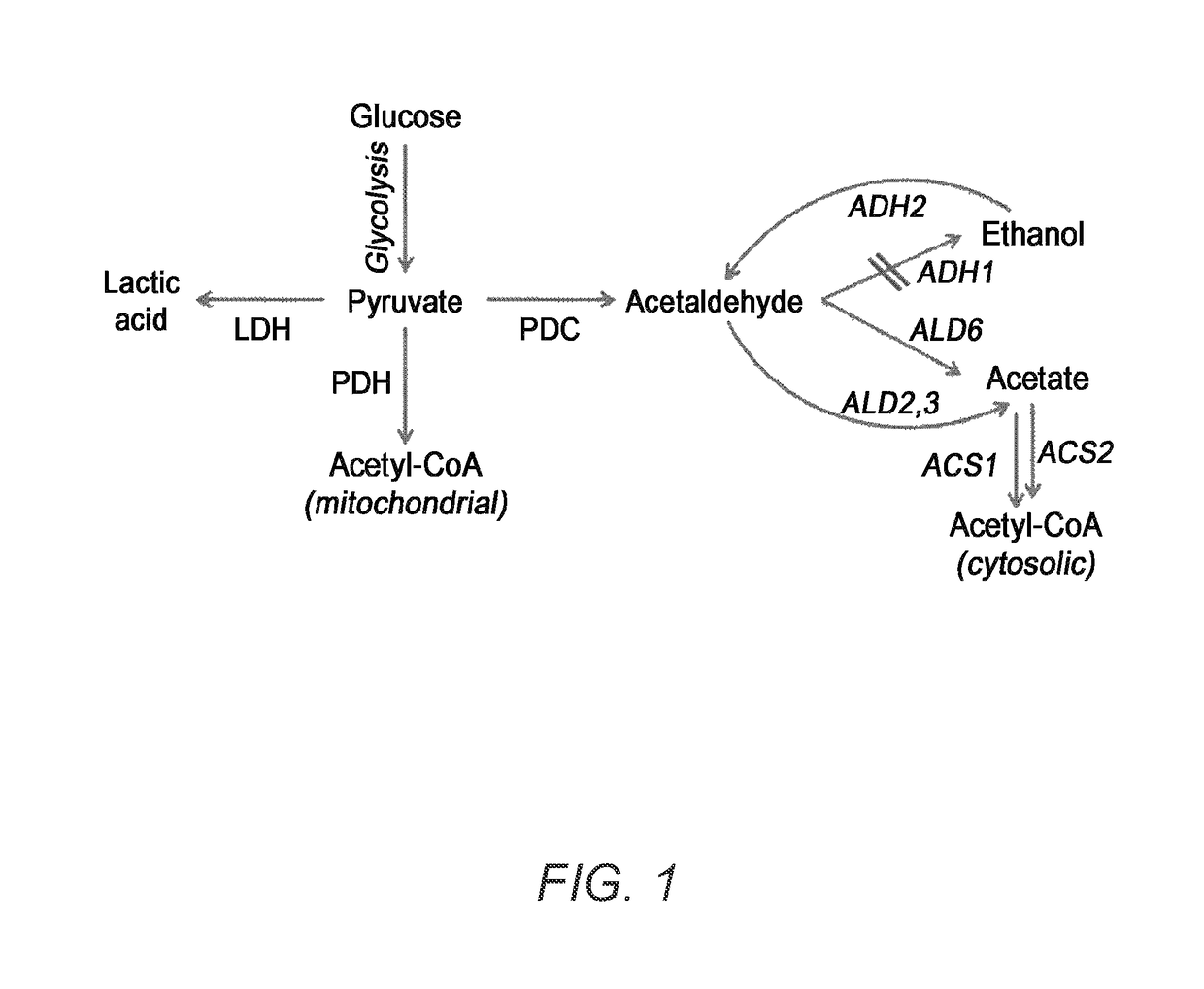Microorganism having enhanced productivity of lactic acid and a process for producing lactic acid using the same
a technology of lactic acid and microorganisms, which is applied in the direction of lyases, ligases, carbon-carbon lyases, etc., can solve the problems of low overall fermentation productivity, difficult control of composition ratio, and limitations on the development of their use, so as to improve the productivity of lactic acid fermentation and increase the activity of aldehyde dehydrogenase
- Summary
- Abstract
- Description
- Claims
- Application Information
AI Technical Summary
Benefits of technology
Problems solved by technology
Method used
Image
Examples
example 1
Preparation of Lactic Acid-producing Strain
[0042]To prepare lactic acid-producing strains, Saccharomyces cerevisiae CEN.PK2-1 D, a representative wild type yeast obtained from EUROSCARF, was subject to genetic manipulation.
[0043]Specifically, a strain, where alcohol dehydrogenase 1 (ADH1) and pyruvate decarboxylase 1 (PDC1) were defective to minimize the loss of pyruvate to the alcohol synthesis pathway, and d-lactic acid dehydrogenase 1 (DLD1) was defective for blocking the D-type lactic acid decomposition pathway, was used as a base strain.
[0044]DLD1 is not a crucial factor that may have a direct impact on the growth improvement, but has been known as a major enzyme capable of converting D-lactic acid to pyruvate using NAD+ as D-lactic acid dehydrogenase. Accordingly, a subsequent strain was constructed based on the strain having gene defects in DLD1, an enzyme that consumes the prepared lactic acid thereof, to compare a complete fermentation productivity of D-type lactic acid-pro...
example 2
Preparation of Mutant Strains Having Decreased PDC5 Activity
[0052]A mutant strain having substituted PDC5 promoter was prepared based on CC02-0064 strain prepared in Example 1. During the process, processes of cassette preparation and strain selection were conducted according to the method disclosed in Lee T. H. et al. (Development of reusable split URA3-marked knockout vectors for budding yeast, Saccharomyces cerevisiae. J Microbiol Biotechnol, 2006, 16:979-982).
[0053]Specifically, a total of five novel strains were prepared by substituting PDC5 promoter of the CC02-0064 strain with SCO1, SCO2, ACS1, IDP2, and FBA1 promoters, respectively, and subsequently, promoter-substituted cassettes were prepared using primers corresponding to nucleotide sequences of SEQ ID NOS: 11 to 36.
[0054]The primers used in the promoter substitution are summarized in Table 2 below.
[0055]
TABLE 2Primers used for the preparation of promoter-substituted strainsPrimers5′->3′ sequenceF_PDC5_UP_676GTCAGCATTGACA...
example 3
Evaluation of Lactic Acid Fermentation for Mutant Strains Having Decreased PDC5 Activity
[0058]An evaluation of lactic acid fermentation was conducted for the PDC5 promoter-mutated strains prepared in Example 2. In this regard, a specific medium was prepared for the evaluation of lactic acid fermentation.
[0059]Specifically, in order to prepare a synthetic complex media (SC media), a limiting medium for yeast, 0.67% yeast nitrogen base without amino acids serving as a base was mixed with amino acid dropout mix (Sigma) according to the protocol of the manufacturer, and added with the amino acids that were excluded in the base, as needed. In addition, 380 mg / L of leucine was added to the resultant, and uracil, tryptophan, and histidine were added at a concentration of 76 mg / L, respectively. 8% of glucose as a carbon source and 1% of CaCO3 as a neutralizing agent were also added. The thus-prepared medium was used for the evaluation of lactic acid fermentation of the yeast strains.
[0060]A...
PUM
| Property | Measurement | Unit |
|---|---|---|
| temperature | aaaaa | aaaaa |
| temperature | aaaaa | aaaaa |
| temperature | aaaaa | aaaaa |
Abstract
Description
Claims
Application Information
 Login to View More
Login to View More - R&D
- Intellectual Property
- Life Sciences
- Materials
- Tech Scout
- Unparalleled Data Quality
- Higher Quality Content
- 60% Fewer Hallucinations
Browse by: Latest US Patents, China's latest patents, Technical Efficacy Thesaurus, Application Domain, Technology Topic, Popular Technical Reports.
© 2025 PatSnap. All rights reserved.Legal|Privacy policy|Modern Slavery Act Transparency Statement|Sitemap|About US| Contact US: help@patsnap.com


